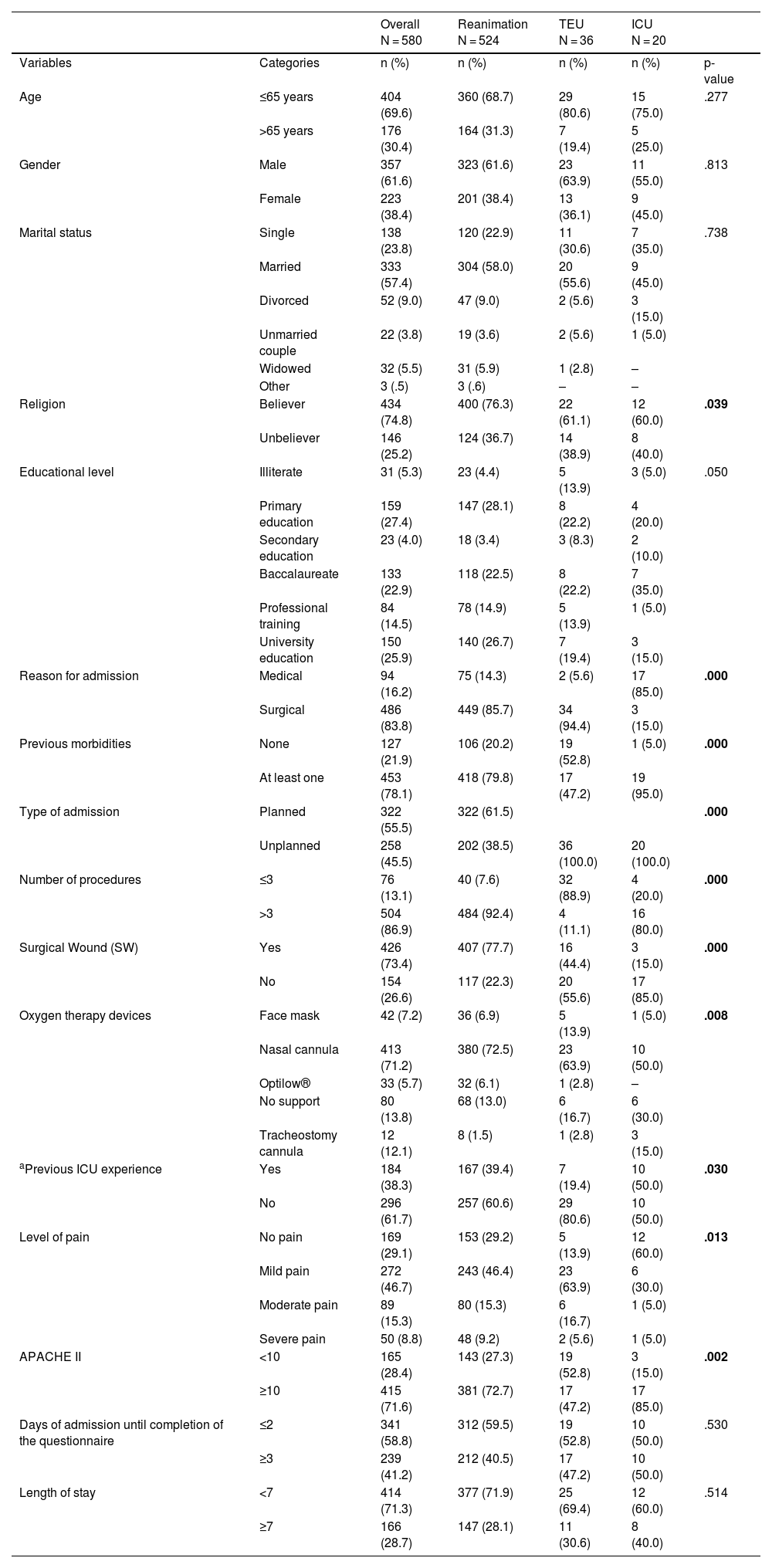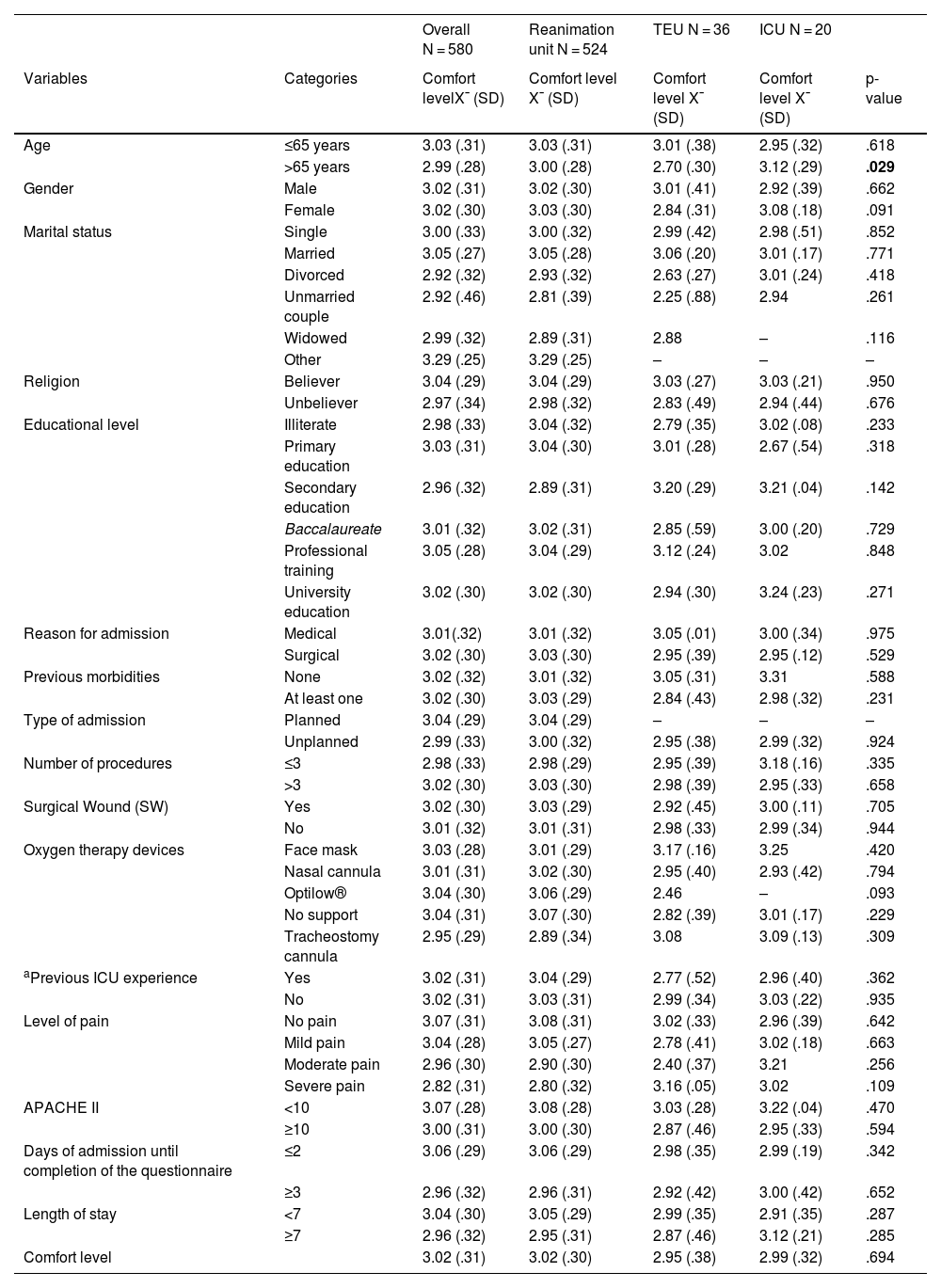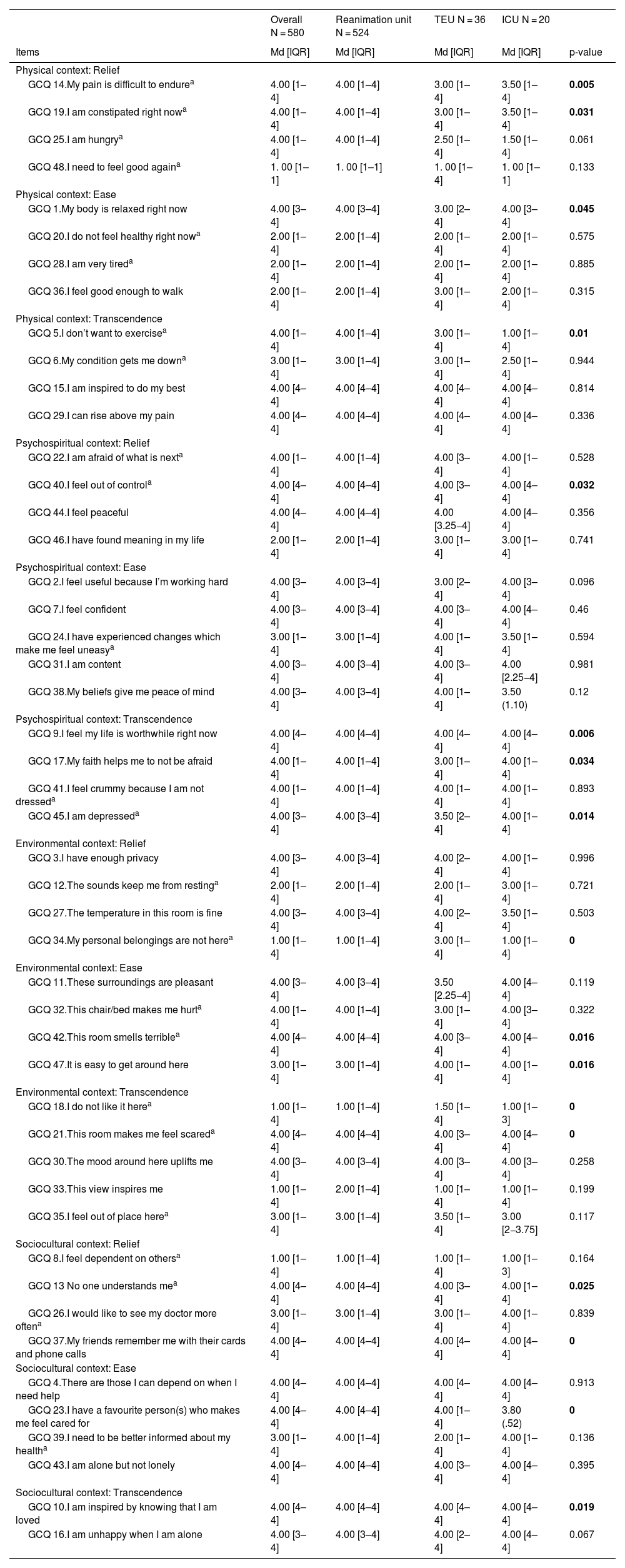The stay in a critical care unit (CCU) has a serious impact on physical condition causing numerous discomfort factors such as pain or difficulty in communicating. All of these are associated with possible sequelae following discharge from the Intensive Care Unit (ICU) named post-ICU syndrome. The Kolcaba Comfort Theory allows, from a holistic approach, to identify care needs from the patient's perspective using instruments such as the General Comfort Questionnaire (GCQ).
ObjectivesTo determine the comfort level of patients admitted to the CCU using the GCQ of Kolcaba and to identify the discomfort factors.
MethodsCross-sectional descriptive observational prospective study. Population: 580 patients admitted to adult CCU of two high complexity hospitals from June 2015 to March 2020 with stay ≥24 h were interviewed. Descriptive analysis, Student's t-test and ANOVA and multivariate analysis were performed using SPSS v26 and STATA v16.
ResultsThe mean age was 52,62 (16,21), 357 (61,6%) were male and 434 (74,8%) were believers. The type of admission was planned in 322 (55,5%) and the most prevalent reason for admission was surgical 486 (83,8%). The median pain score (NRS) was 3,00 [0–4] and severity score (APACHE II) was 13,26 (5,89), the median length of stay was 4,00 [2–7] days. The mean comfort level was 3,02 (0,31) showing the highest value Reanimation 3.02 (0.30) and the lowest Trauma and Emergency Unit 2.95 (0.38). Statistically significant differences were found between the units in the comfort level of patients >65 years of age (p = 0.029). The Relief comfort type obtained the lowest mean 2.81 (0.33) and the physical context 2.75 (0.41) in the three units. In the multivariate analysis, statistically significant differences were found between the comfort level and the pain level: no pain (p = 0,000) OR 4,361 CI [2,184−8,707], mild pain (p = 0,000) OR 4,007 CI [2,068−7,763], moderate pain (p = 0,007) OR 2,803 CI [1,328−5,913], and the APACHE II score equal to or greater than 10 (p = 0,000) OR 0,472 CI [0,316−0,705].
ConclusionsThe comfort level showed high scores in all three units. The physical and environmental contexts and the relief comfort type negatively affected the perception of comfort. The variables that explained comfort were pain and severity of illness. The evaluation of comfort from the patient's perspective through the GCQ could be considered an indicator of quality of nursing interventions.
La estancia en una unidad de cuidados críticos (UCC) supone un grave impacto sobre la condición física causando numerosos factores de incomodidad como dolor o dificultad para comunicarse. Todos ellos se asocian con posibles secuelas posteriores al alta de la Unidad de Cuidados Intensivos (UCI) conocidos como síndrome post-UCI. La Teoría del Confort de Kolcaba permite, desde una aproximación holística, identificar las necesidades de cuidados desde la perspectiva del paciente mediante instrumentos como el Cuestionario General de Confort (GCQ).
ObjetivosConocer el nivel de confort de los enfermos ingresados en UCC mediante el GCQ de Kolcaba e identificar los factores de incomodidad.
MétodoEstudio observacional descriptivo transversal prospectivo. Población: Se entrevistó a 580 pacientes ingresados en tres UCC de adultos de dos Hospitales de alta complejidad desde junio 2015 a marzo 2020 con estancia ≥24 h. Se realizó análisis descriptivo, Test de la T de Student y ANOVA y análisis multivariante utilizando SPSS v26 y STATA v16.
ResultadosLa edad media fue 52,62 (16,21), siendo hombres 357 (61,6%) y 434 (74,8%) refirieron ser creyentes. El tipo de ingreso fue programado en 322 (55,5%) y el motivo de ingreso más prevalente quirúrgico 486 (83,8%). La mediana de la puntuación de dolor (EVN) fue 3,00 [0–4] y la de gravedad (APACHE II) fue 13,26 (5,89), la mediana de estancia fue 4,00 [2–7] días. La media de nivel de confort fue 3,02 (0,31), mostrando el valor más elevado Reanimación 3,02 (0,30) y el más bajo la UTE 2,95 (0,38). Se encontraron diferencias estadísticamente significativas entre las unidades en el nivel de confort de los pacientes con >65 años(p = 0,029). El tipo de confort Alivio obtuvo la media más baja 2,81 (0,33) y el contexto físico 2,75 (0,41) en las tres unidades. En el análisis multivariante se encontraron diferencias estadísticamente significativas entre el nivel de confort y el nivel de dolor: sin dolor (p = 0,000) OR 4,361 IC [2,184−8,707], dolor leve (p = 0,000) OR 4,007 IC [2,068−7,763], dolor moderado (p = 0,007) OR 2,803 IC [1,328−5,913], y la puntuación APACHE II igual o superior a 10 (p = 0,000) OR 0,472 IC [0,316−0,705].
ConclusionesEl nivel de confort mostró puntuaciones elevadas en las tres unidades. Los contextos físico y ambiental y el tipo de confort alivio afectaron negativamente a la percepción del confort. Las variables que explican el confort ajustadas por tipo de unidad son el nivel de dolor y la gravedad. La evaluación del confort desde la perspectiva del paciente mediante el GCQ podría ser considerado un indicador de calidad de las intervenciones enfermeras.
Artículo
Diríjase al área de socios de la web de la SEEIUC, (https://seeiuc.org/mi-cuenta/iniciar-sesion/) y autentifíquese.
Comprando el artículo el PDF del mismo podrá ser descargado
Precio 19,34 €
Comprar ahora











